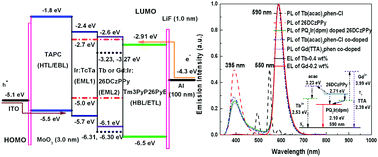High performance red phosphorescent organic electroluminescent devices with characteristic mechanisms by utilizing terbium or gadolinium complexes as sensitizers†
Abstract
In this work, we demonstrated the efficacy and feasibility of utilizing terbium and gadolinium complexes with low-lying energy levels to sensitize red-emitting iridium complexes in organic light-emitting diodes (OLEDs). Compared with devices without the introduction of a sensitizer, the obtained sensitized devices showed remarkably enhanced electroluminescence performances, which can be attributed to improved carrier balance as well as a wider recombination zone. Moreover, characteristic sensitizer emission was invisible in all sensitized devices due to the inferior hole trapping ability of sensitizer molecules. Finally, the sensitized device co-doped with 0.4 wt% of the terbium complex realized superior electroluminescence performances with maximum brightness, current efficiency, power efficiency and external quantum efficiency as high as 145 071 cd m−2, 64.87 cd A−1, 69.11 lm W−1 and 24.7%, respectively. Meanwhile, even at the practical brightness of 1000 cd m−2 (4.0 V), outstanding external quantum efficiency and current efficiency up to 22.7% and 59.7 cd A−1, respectively, were obtained.



 Please wait while we load your content...
Please wait while we load your content...